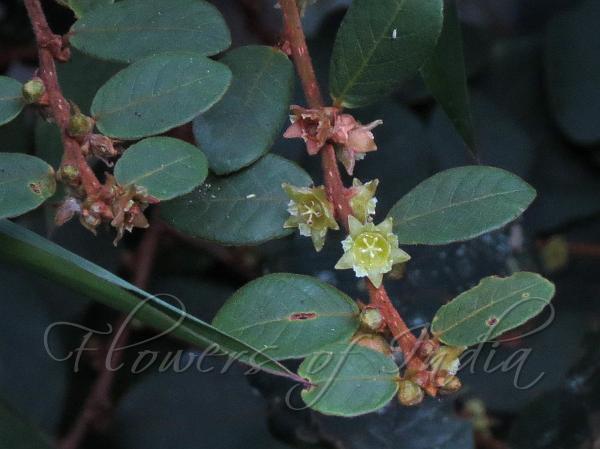|
| Climbing Bridelia |
|

|

| File size | 290331 |
| Original date | 10/31/13 3:24 AM |
| Resolution | 1400 x 1050 |
| Flash | Flash did not fire, auto |
| Focal length | 23.766mm |
| Exposure time | 1/200s |
| Aperture | 5.6 |
| Focus Distance | |
| Metering Mode | Center weighted average |
| Camera make | Canon |
| Camera model | Canon PowerShot SX40 HS |
| Sensor type | OneChipColorArea |
|
|
|
|
Photo: |
Botanical name: Bridelia stipularis Family: Phyllanthaceae (Amla family)
Synonyms: Bridelia scandens, Bridelia zollingeri, Bridelia dasycalyx
Synonyms: Bridelia scandens, Bridelia zollingeri, Bridelia dasycalyx
Climbing Bridelia is a large, evergreen climbing
shrub. Leaves are 5-20 cm, somewhat leathery, elliptic-obovate or
orbicular-oblong. Flowers are small, in small axillary clusters or long
spikes, often subtended by long stipular bracts. Flowers are borne in
usually 2-6-flowered clusters in leaf axils, sometimes grouped into
many-flowered spikes or on terminal small-leaved branches. Male flowers
are 0.6-1 cm in diameter, on very short stalks up to 1 mm. Receptacle
is cup-shaped, sepals ovate-triangular, about 4 x 2.5 mm. Petals are
spoon-shaped, about 2 mm, 3-5-toothed, disk shallowly cup-shaped, 5-6
mm in diameter. Fruits are oblong, 1.2 cm long, sitting on an enlarged
calyx. Climbing Bridelia is found in Nepal, India, Sikkim, Burma, SW
China, Indo-China, W Malaysia.
Medicinal uses:  Plant is used in pleurisy and exudation. Bark decoction is given to
children for cough, fever and asthma and as gargle for sores in mouth.
Fresh tender leaves are used for the treatment of jaundice; emulsion
for anaemia due to pregnancy. Leaf powder and warm leaf poultice are
applied to white spots in the skin. The roots are used as medicine for
reducing inflammation and as an astringent antidiarrheal; the fruits
are used to induce vomiting and as an antitoxic.
Plant is used in pleurisy and exudation. Bark decoction is given to
children for cough, fever and asthma and as gargle for sores in mouth.
Fresh tender leaves are used for the treatment of jaundice; emulsion
for anaemia due to pregnancy. Leaf powder and warm leaf poultice are
applied to white spots in the skin. The roots are used as medicine for
reducing inflammation and as an astringent antidiarrheal; the fruits
are used to induce vomiting and as an antitoxic.
 Plant is used in pleurisy and exudation. Bark decoction is given to
children for cough, fever and asthma and as gargle for sores in mouth.
Fresh tender leaves are used for the treatment of jaundice; emulsion
for anaemia due to pregnancy. Leaf powder and warm leaf poultice are
applied to white spots in the skin. The roots are used as medicine for
reducing inflammation and as an astringent antidiarrheal; the fruits
are used to induce vomiting and as an antitoxic.
Plant is used in pleurisy and exudation. Bark decoction is given to
children for cough, fever and asthma and as gargle for sores in mouth.
Fresh tender leaves are used for the treatment of jaundice; emulsion
for anaemia due to pregnancy. Leaf powder and warm leaf poultice are
applied to white spots in the skin. The roots are used as medicine for
reducing inflammation and as an astringent antidiarrheal; the fruits
are used to induce vomiting and as an antitoxic. | Identification credit: Ajit Ampalakkad | Photographed in Dandeli, Karnataka. |
• Is this flower misidentified? If yes,